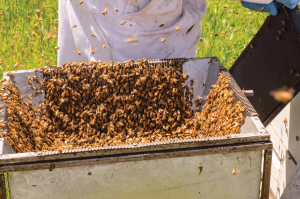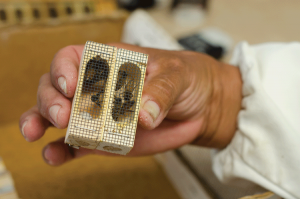By: Larry Connor

When bees are being shaken for packages, nurse bees, drones and the queen often end up in the shaking basket. The nurse bees go through to a cage below. The queen and drones are returned to the colony by turning the basket over and dumping it on the top of the hives’s frames. Or the queen may be captured and crushed on the ground, allowing for the colony to be requested the next day.
The young worker looked at the owner, dumbfounded. “You want me to kill all the queens I find in these colonies?”
The owner skillfully and carefully explained his request, “This yard contains mostly two-year old queens. This Spring we have shaken these colonies for mating boxes, pulled out frames of brood for cell builders, and today you are shaking nurse bees for packages. This is the second time we have shaken these colonies for packages. It is time to smash her with your hive tool and I will come through tomorrow to introduce newly mated queens.”
The worker looked at him quizzing, so the owner went on, “This way we will have an entire yard filled with young queens for the almonds and for shaking bees next year. We must constantly plan ahead.”
The queens the worker was asked to crush were beautiful – long and productive egg layers. It takes a strong manager to order the replacement of hundreds of queens like her. “I have learned that the most important queen customer our business has is ourselves,” the beekeeper explained. “Customers may be crying for queens, but If we don’t take queens out of our production and sales cycle and replace our old queens with new, we will be in trouble next season.”
Few of us can even begin to understand the experiences the scale of a large queen rearing and package bee operator. But we should all re-read what the queen producer said about replacing a good-looking queen and planning for next season. We will discuss some of the conditions under which the average beekeeper should replace young queens, or queens that are doing a great job but we expect will reach the end of its productive live in a few months or over the Winter.
Replacing Young Queens in Packages and Nuclei Colonies
More and more beekeepers are replacing queens soon after they received their new package colonies, or even in nucleus colonies. Generally, they let the original queens build the colony to a level they find acceptable, while feeding the bees, monitoring mite loads and searching for brood diseases. They allow one to three months of the original queen’s brood to develop and emerge so they may evaluate the queen’s workers for productivity and defensiveness.
This is especially true for areas on the fringe of African honey bee occupation. Most northern beekeepers do not want colonies that have queens that have mated with one or more African drones, or drones that are hybrids of European and African races. Beekeepers must monitor colony behavior, especially in urban and suburban locations, and one to three months is adequate for this monitoring. Commercial beekeepers tolerate a degree of subtle Africanization and will most likely move the bees back to their southern location at the end of the honey season. Most small-scale and semi-professional beekeepers cannot tolerate the risk of stinging attacks to ruin a good location. The other aspect of elimination of African-tainted queens is the potential for decreased wintering success. I am not sure that this is actually happening, but why take the chance? Most beekeepers do not want or need to increase their problems with getting bees through the Winter in good condition.

Two California queen cages, containing one queen and workers in each cage. These are shipped in packages or in battery boxes by overnight delivery.
In a wider evaluation of queens that come in package colonies and nucleus hives, beekeepers are frequently dissatisfied that these queens are suitable for the conditions in their local area. This appears to address a lack of adaptiveness or genetic fit. A queen raised in California or Georgia may have traits for New York or South Dakota, but usually only when the breeder stock that provided larvae for the grafting rooms was selected in these areas on an intentional and rigorous basis. We talk more and more about Localized Queens or Survivor Stocks. A queen found in a swarm or a bee tree may represent most anything genetically, while a line of related queens that has been carefully selected over many years may be ideal for the Sun Belt queen producer to use in packages and nuclei production.
More and more I hear of northern beekeepers and queen rearing cooperatives programs providing key breeder queens to queen and queen cell producers in Sun Belt states to provide stock for their needs.
Large commercial queen producers have other strategies to produce genetically improved queens. In California, the work by Sue Cobey is evident in operations like Valery Strachan’s Strachan Apiaries in Yuba City. Valarie produces 200 instrumentally-inseminated breeder queens every June for her evaluation. Half of the queens are used as grafting mothers in her operation the following year, while the remaining queens are sold. There is apparently a long list of people waiting for these queens. The stock started as New World Carniolian.
Other large queen producers have one or more lines of queens that they develop in isolation in northern locations over the summer, or, in some cases, produce under agreement with the producer of the stock. This was the basis of the old Starline program that I ran from 1976 to 1980. While that stock is no longer available, Buckfast queens are being produced in Ontario and the Olivarez Honey Bee operation is producing Italian, Carniolian and Saskatraz queens in Hawaii, Northern California and Montana. To do this, separate areas are established to maintained to provide some degree of mating isolation for the production queens.
Requeening to obtain a desired stock
Not all packages and nuclei contain the queens you eventually want to develop new hives. Like the young employee learning how to manage an apiary, you must learn to replace a young or seemingly productive queen with the stock you want. If you are unable to smash the queen with a hive tool, you could use the queen to install into a support nucleus colony (brood factory) or use her to be the star of an observation hive.
Some young queens have problems, such as poor mating (running out of sperm in a month or two after starting to lay), were damaged during shipping by overheating, or were exposed to miticide during development. You cannot and must not continue with these queens.
If you install a queen that came in a package of bees and she dies during introduction or she never starts to lay, or if she disappears, you should contact your package bee supplier for an immediate replacement.
If you have a laying queen, you must find and remove her. In smaller colonies you can go through the combs, frame by frame. Set aside each frame so the queen cannot crawl back to frames you just inspected. Use an empty hive body for that, or set the frames, on their ends, against a hive body or secure structure so the frames cannot crush bees and the queen. Search all frames for a second queen, just in case.
When you find the queen, pinch off her head or crush her with the hive tool. Toss her body some distance away from the hive so the bees are not confused by her body’s presence. Once killed, pheromone production comes to an end.
There is debate about how soon you can introduce the new queen. I do it immediately after the old queen is gone. Once introduced, I delay the release of the new queen for three to seven days, depending on her relatedness to the bees in the colony and cost of the queen. Unrelated and expensive queens are held in the colony for five to seven days so there is plenty of time for the queen’s pheromone to mix with the bees, and for the queen’s ovaries to swell and produce abundant eggs, even in the cage. With three hole and California queen cages, leave the cork in the end of the cage. You may put a piece of duct tape over the end so the bees cannot (or are slowed) chew out the cork. If you use a Jz’s-Bz’s queen cage, use the plastic cap on the nipple of the cage, which is filled with queen candy.
When you return, enter the colony with a minimum of smoke and gently remove the cork or plastic cap and return the queen cage to the same location for emergence. Look at the queen while you do this, as you do not want to release a queen that has been damaged by the bees. After the cap or cork are removed, return the cage and gently close the hive.
In seven to 10 days you can return to check the queen is released and laying. With mated queens this should be around 98% successful. Unfortunately, there is always the risk of losing a few queens during introduction.
Finding the queen in a large hive
If you received your package or nucleus in April, and it is now late June or July, you should have a large colony. You ask, How Do I Requeen That?
This is where many beekeepers give up on requeening, saying that the queen must be great because the colony is so large and producing honey. If this makes sense to leave the queen you have saved some work. But ask yourself – will this colony be alive next March?
If the answer is NO (based on poor experience, perhaps with Italian bees brooding up all Fall and into the Winter), then you need to find and replace the queen.
Taking a method from crews that shake bees for packages, you should shake all the bees in a hive through a queen excluder. With a little smoke, the bees will move through the excluder and leave the drones and the queen above the excluder. Keep the drones, but remove the queen and pinch her.
Reassemble the colony and introduce your new queen (kept in a cool place while all this was going on). Make sure you place her in the middle of the brood nest.
Using queen cells
During the nectar flow, many beekeepers introduce a queen cell to the honey super (no queen excluder on the hive) and let the young queen and old queen determine hive politics.
For the Saskatraz queen program (http://saskatraz.com/pages/articles.htm), an agreement was developed with the Canadian producers of the stock. Here is a section of the report of their 2015 program:
“Every year colonies are selected for honey production, overwintering ability, temperament, mite resistance and brood diseases. Selections are made from at least 1500 colonies per year at Meadow Ridge apiaries [in Saskatchewan]. In addition, selections contributed (exchange of queen cells, etc.) by other Saskatchewan beekeepers are also evaluated. Some of the selected colonies are placed in natural selection apiaries to test for mite resistance (recurrent natural selection), others are placed in separate apiaries to evaluate honey production and other traits. Breeder queens are selected after two to three year evaluations and virgin queens from selected breeders are crossed (close population mated) at natural selection apiaries to improve varroa tolerance, and at apiaries with selections for high honey production to maintain productivity. In the last few years we have set up a natural selection apiary with colonies bred for high VSH activity, and in 2015 an apiary with colonies selected to produce diverse drones from colonies selected for economic traits (honey production, wintering ability, and varroa tolerance) from 7 different Saskatraz families. This should maintain genetic diversity as well as enriching for alleles carrying beneficial traits.
“Saskatraz queens mated at these apiaries undergo preliminary evaluation (brood pattern, temperament, etc.), and are sent to Orland California in late September of each year. The progeny from these queens are screened for viruses (DWV, IAPV, and KBV) and microsporidia (Nosema apis and ceranae). This information is used to make final selections in California. In 2015 we sent 120 queens to be reselected in March 2016. They are established in colonies after dequeening resident California queens. Colonies are treated for varroa about 30 days prior to introducing Saskatraz queens. Treatments in 2015 were in August with Apivar strips.
“Over the last few years the California Tech Transfer Team, Bee informed Partnership has independently evaluated our Saskatraz breeding stock in late February early March. Evaluation included hygienic testing (uncapped, removed), colony strength (frames of brood), brood pattern (1-poor to 5-best), queen status, temperament (1- best to 5- poor), color, varroa infestation (Mites per Hundred Bees) and nosema spore count.
“In mid-March Albert Robertson does the final colony evaluations and selects approximately 10 to 20 of the best queens to graft from. Final selections include evaluations for colony strength, phoretic varroa, varroa in drone and worker brood, brood pattern, brood diseases (chalk brood etc.), and temperament. Saskatraz hybrids are produced from these breeders to distribute to Canadian beekeepers.”










